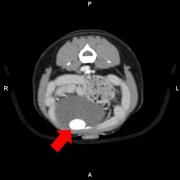Leaving No [Bladder] Stone Unturned

Leaving No [Bladder] Stone Unturned
The veterinarians at The Animal Medical Center attended to several canine patients last week – Chompers, Maxie and Theo – all of whom were suffering from bladder stones, technically called cystic calculi. Bladder stones form when the urine contains excess amounts of a substance, usually a mineral, such as calcium or phosphate. The cause of the excess can be due to diet, abnormal metabolism, a genetic defect, or most commonly, a urinary tract infection.
X-rays can be used to find some bladder stones. Below, you can easily see the four stones in poor Chompers’ bladder. His stones were easily found, but that is not always the case. For example, dogs with stones resulting from an abnormal liver blood vessel, or from the a very specific kidney abnormality of Newfoundland dogs, stones require identification through ultrasound testing.
The second patient, Maxie the Maltese, had several stones identified on an ultrasound performed because she was having accidents in the house. A urine sample was submitted to the lab, which showed an infection. Treatment with antibiotics was given to control the infection, but additional treatment will be necessary to remove the stones.
Theo, a one year old Yorkshire terrier came to The AMC’s ER for blood in his urine. Because abnormal liver blood vessels and bladder stones are common in Yorkies, his surgeon performed an abdominal CT scan to investigate. The scan confirmed a half inch diameter bladder stone and an abnormal liver blood vessel. Both the stone and the abnormal blood vessel were corrected during surgery.
Rock removal
The traditional method of removing bladder stones requires surgery, which is a procedure many general veterinarians routinely perform. Once the bladder is accessed via a skin incision, the bladder is opened and a scoop is used to remove the stones. After closure of the incisions, an x-ray is taken to ensure all stones have been successfully removed.
These days, there are as many methods of stone removal as there are stones in some bladders. Non-surgical methods sound easy, but calculolytic (stone dissolving) diets work for certain stones, called struvite. Urohydropulsion flushes small stones out of the bladder, but will not work if the stones are too large. Another method of non-surgical stone removal is lithotripsy. Bladder stones are pulverized using lasers, allowing the fragments to pass through the urine.
Minimally invasive methods of stone removal can also be used. These procedures require an endoscope which enters the bladder after passing through a skin incision.
Signs your pet may have bladder stones:
- Accidents in the house
- Bloody urine
- Staining to urinate
If you see any of these, have your pet evaluated by your veterinarian immediately, because bladder stones make your pet uncomfortable and there is a risk of a urinary blockage if the stones lodge in the urethra.
All the treatments described above are available at The Animal Medical Center, including the minimally invasive procedures such as lithotripsy. If you suspect your pet may have bladder stones, our veterinarians are on site 24/7 to diagnose and treat your pet.

































